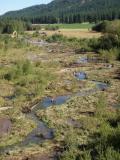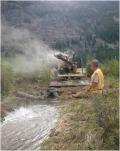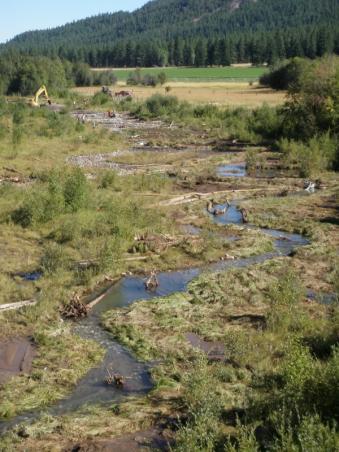Dramatic declines in the abundance of anadromous Pacific salmonids have occurred over the last century in the Columbia River basin. Population declines followed harvest, hydrosystem and watershed development, habitat loss and degradation, and reduced survival in freshwater, estuary, and marine environments. These declines are accompanied by greatly reduced levels of natural production due to an array of anthropogenic factors. While physical habitat loss and degradation, loss of marine derived nutrients (MDN), and the deleterious presence of non-native fishes are recognized as three critical limiting factors, natural production in many imperiled populations may be simultaneously co-limited by multiple factors. Thus, successful salmon restoration programs for co-limited populations will likely require multiple restoration treatments, along with a standard, comparable methodology to characterize the complex biological responses to these restoration treatments.
Food webs provide such a methodology, by describing how food and energy are routed through ecosystems, and by providing insight into the complex, multi-species assemblages within which organisms of interest grow, survive, and reproduce. While food webs have traditionally been used to characterize and compare ecological conditions within or between biological systems, they can also provide great benefit as a monitoring tool to evaluate the complex responses to multiple restoration actions for salmonids.
In this study we use food flow webs to characterize: (1) the effects of physical habitat degradation, the loss of marine derived nutrients, and the deleterious presence of non-native fish (brook trout) on natural production; and (2) the individual and additive effects of physical habitat restoration, nutrient addition, and brook trout removal treatments on production of ESA-listed Chinook salmon and steelhead, and on supporting trophic ecology. This study is being conducted in Hancock Springs, a small spring creek in the Methow River Subbasin. The study design includes temporal and spatial controls to evaluate sequential implementation of restoration treatments. Physical habitat restoration (channel and riparian zone reconstruction) occurred during 2011, with annual nutrient addition beginning in 2015 and brook trout removal beginning in 2017. A multi-trophic level biomonitoring program is ongoing to address the separate and additive effects of multiple restoration treatments.
The goal of the Program is to identify, test, evaluate, and implement measures to increase natural production of threatened and endangered resident and anadromous salmonids in the Upper Columbia River Basin. The Program’s ecosystem-based approach is expected to provide ecological benefits to an array of critical food web components and trophic functions and processes required for natural production.
Hancock Springs: small, fine-scale project that evaluates the sequential and additive treatment effects
- Physical habitat restoration
- Nutrient enhancement
- Removal of non-native invasive fishes (e.g., brook trout)
Treatments
- Initial habitat treatment in Hancock Springs was completed in 2011. This included 300 meters of complete channel restoration (can be viewed in attached power point).
- Nutrient enhancement is planned for 2015.
- Non-native (e.g., brook trout) removal is planned for 2017.
- Second phase of habitat restoration is planned for 2019.
Monitoring
Both physical and biological variables are extensively monitored. We use empirical and mechanistic food web models to dessiminate treatment effects equaly accross restoration treatments.















